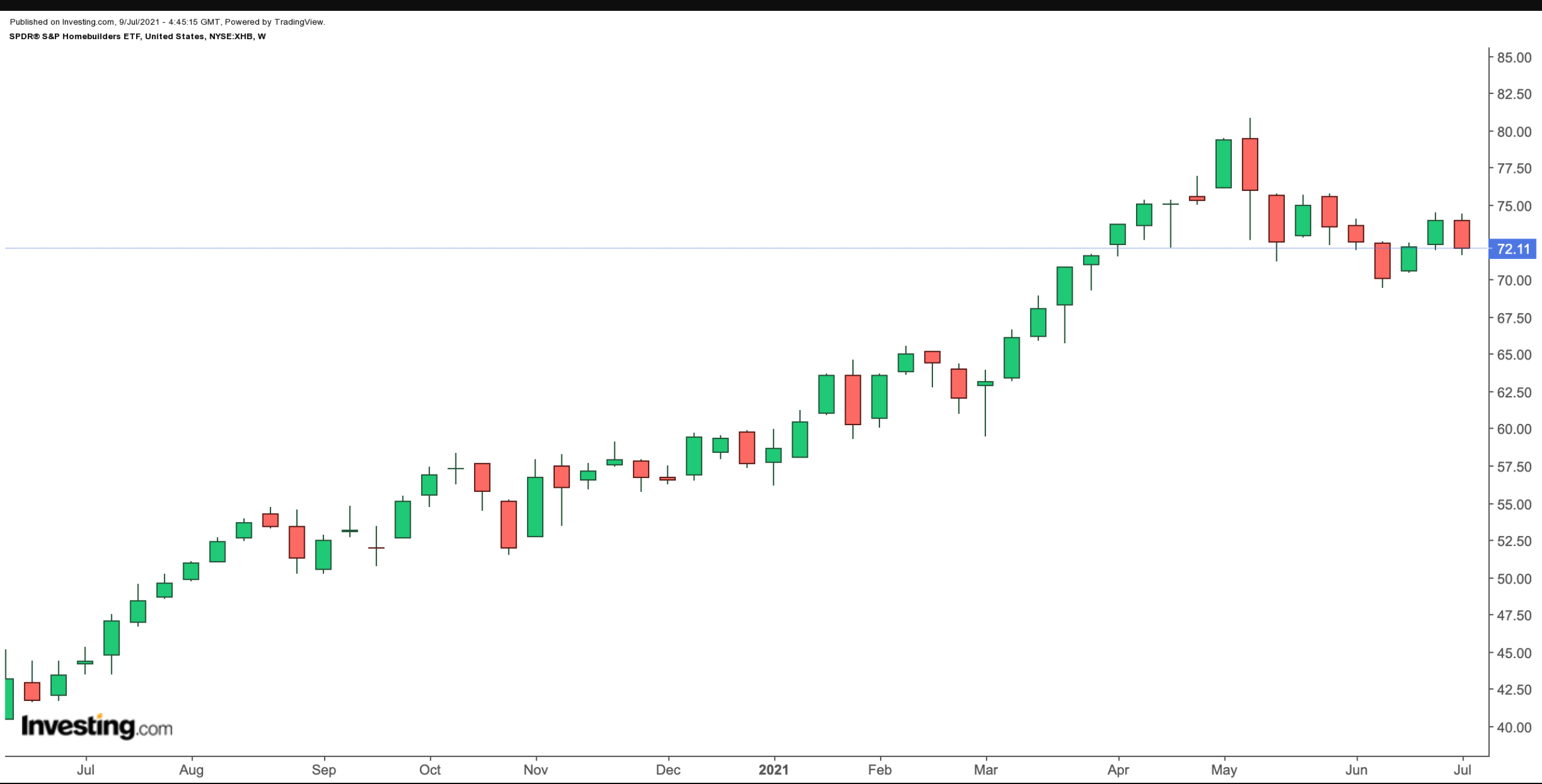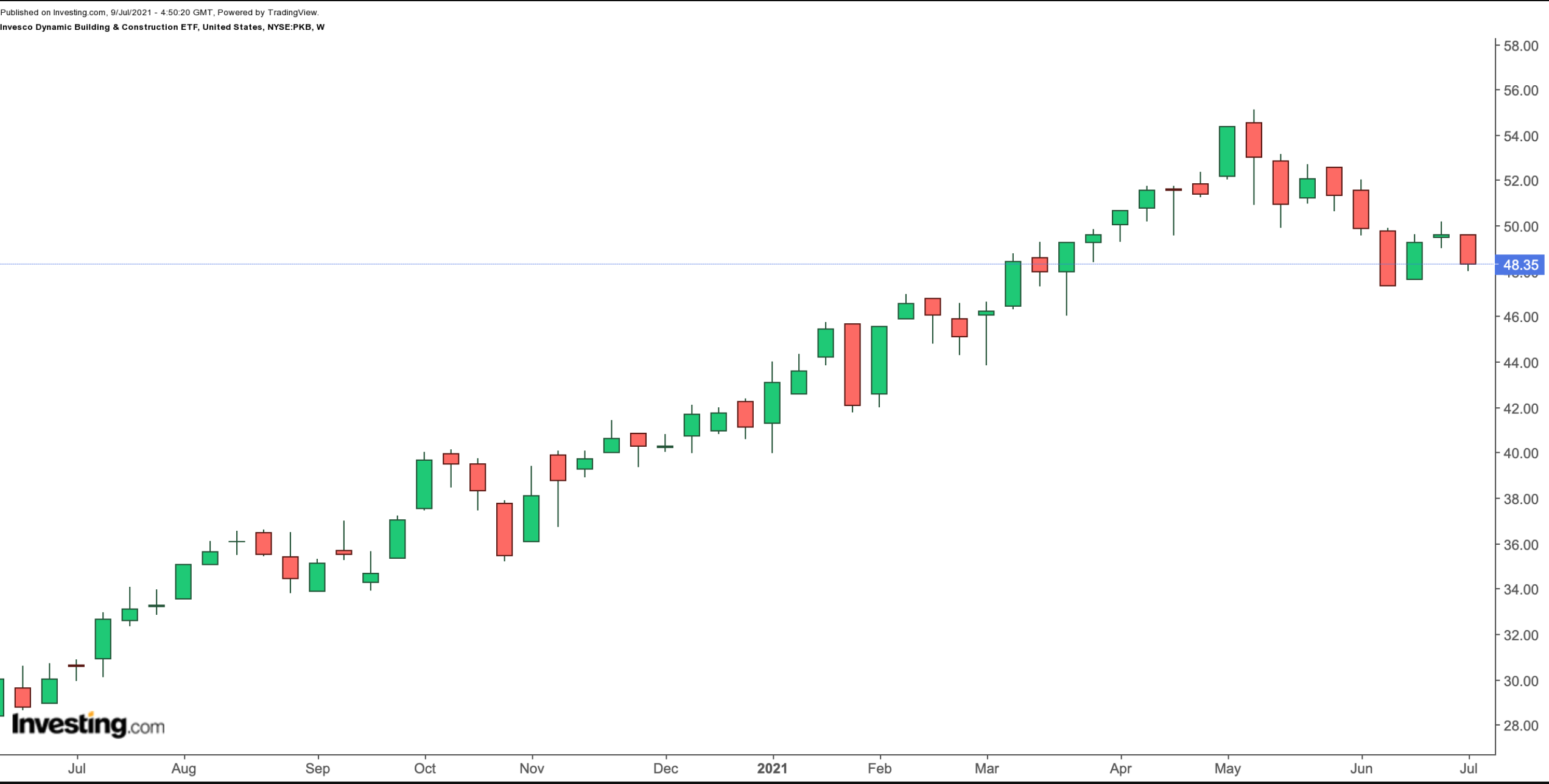US housing data on Building Permits, Housing Starts and Existing Home Sales typically get significant investor attention. According to the residential construction statistics released jointly by the US Census Bureau and the US Department of Housing and Urban Development on June 16, home-building rebounded in May. Housing starts increased by 3.6% to a seasonally adjusted annual rate of 1.572 million units in the month.
Shortage of previously owned homes for sale contributed to the strength in numbers. In addition, the increase in the price of lumber and shortages of building materials have also become part of the equation in the home-building sector.
Over there past year, investors have been bullish on home-builders. For instance, the Dow Jones US Select Home Construction is up about 52.5% in the past 52 weeks and 28% year-to-date.
Now, analysts are debating whether sales can continue to stay strong if long-term rates were to rise in the second half of the year. Given that we’re about to enter a busy earnings season, some could potentially consider taking profits on their gains so far in the year.
Different sides of the argument help make a market on Wall Street. Therefore, today we discuss two exchange-traded funds (ETFs) for readers who believe the the long-term strength in the housing sector is likely to stay.
1. SPDR S&P Homebuilders ETF
Current Price: $72.11
52-Week Range: $43.27 - $80.82
Dividend Yield: 0.58%
Expense Ratio: 0.35% per year
The SPDR® S&P Homebuilders ETF (NYSE:XHB) invests in the home-builders segment. Among the sub-industries are building products, home improvement, and retail furnishings and household appliances.

XHB, which has 35 holdings, tracks the S&P Homebuilders Select Industry index. XHB is an equal-weighted fund and no company has a weighting of more than 3.9%. Since its inception in January 2006 assets under management have grown to $1.9 billion.
Among the top companies are home-builders NVR (NYSE:NVR), Lennar (NYSE:LEN); retailers Floor & Decor Holdings (NYSE:FND) and Home Depot (NYSE:HD); and Carrier Global (NYSE:CARR), which provides heating, ventilation and air conditioning (HVAC), refrigeration, fire and security solutions.
So far in the year, XHB is up 24.5%, and hit a record high in May. Its trailing P/E and P/B stand at 13.95 and 3.44, respectively. The housing market in the US has been extremely robust. Yet, if interest rates were to increase, XHB's price ascent could slow down and consolidation could follow. Interested readers could then enter the fund at a more attractive price, around $70, or even below.
2. Invesco Dynamic Building & Construction ETF
Current Price: $48.35
52-Week Range: $29.91 - $55.10
Dividend Yield: 0.25%
Expense Ratio: 0.59% per year
The Invesco Dynamic Building & Construction ETF (NYSE:PKB) provides exposure to US building and construction companies based on several criteria, including price momentum, earnings, management action and value. The fund covers a broad group of companies that focus on home improvement, general construction or large-scale infrastructure projects, like highways, bridges, tunnels, bridges, airports and power lines.

PKB, which tracks the Dynamic Building & Construction Intellidex℠ Index, is rebalanced quarterly. The fund started trading in October 2005, has a market value of $292 million.
The most important sectors are household durables (27.3%), construction materials (16.99%), specialty retail (16.02%), construction and engineering (13.39%), and building products (13.04%). PKB currently has 30 holdings, and the top 10 holdings comprise around 46% of net assets.
Among the largest five companies are the the global diversified technology and multi-industrial group Johnson Controls International (NYSE:JCI), global climate solutions provider Trane Technologies (NYSE:TT), home improvement retailers Home Depot and Lowe’s (NYSE:LOW), and homebuilder and financial services provider PulteGroup (NYSE:PHM).
So far this year, the fund is up more than 17.7% and has returned 57.4% in the past 52 weeks. Trailing P/E and P/B ratios of PKB are 16.76 and 3.34, respectively. Construction is a cyclical industry and the post-COVID era could lead to the next bullish leg. A potential decline toward $45 would improve the margin of safety.
